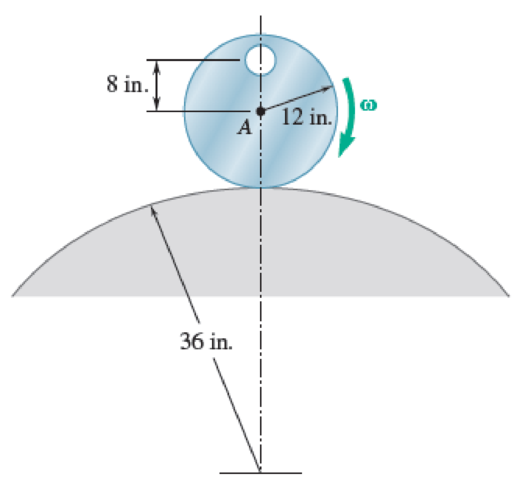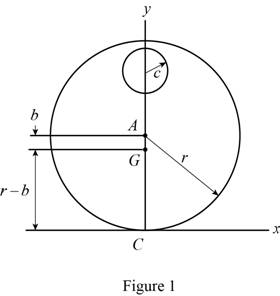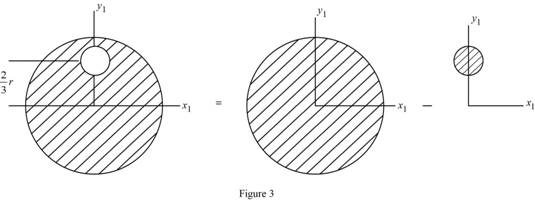
A cylinder with a circular hole is rolling without slipping on a fixed curved surface as shown. The cylinder would have a weight of 16 lb without the hole, but with the hole it has a weight of 15 lb. Knowing that at the instant shown the disk has an angular velocity of 5 rad/s clockwise, determine (a) the angular acceleration of the disk, (b) the components of the reaction force between the cylinder and the ground at this instant.

Fig. P16.161
(a)
The angular acceleration of the disk.
Answer to Problem 16.161RP
The angular acceleration of the disk is
Explanation of Solution
Given information:
The weight of the cylinder without hole is
The weight of the cylinder with hole is
The angular velocity of the disk is
Calculation:
Consider the acceleration due to gravity as
Consider that the mass center of the cylinder is G and it lies at a distance b from center A, and C is the contact point between cylinder and the curved surface is the origin of the coordinate system.
Consider that the radius of cylinder is r and the radius of the curved surface is R.
Sketch the geometry of the cylinder as shown in Figure 1.

Refer to Figure 1.
Calculate the position vector
The position vector of P with respect to C.
The position vector of G with respect to C.
The position vector of A with respect to C.
The cylinder rolls without slipping on a fixed curved surface hence, the horizontal component of acceleration of point C is
Calculate the acceleration of point C
Substitute 0 for
The acceleration of the disk at A is
Calculate the acceleration of point A
Substitute
Calculate the acceleration of point P
Here,
Substitute
Calculate the acceleration of point G
Substitute
Calculate the acceleration of point A
Substitute
Subtract Equation (2) from Equation (1) as shown below.
Substitute
Calculate the velocity of point A
Calculate the vertical component of acceleration of point A
Substitute
Calculate the acceleration of point G
Substitute
Calculate the effective force at the mass center
Sketch the Free Body Diagram of the cylinder as shown in Figure 2.

Refer to Figure 2.
Apply the Equilibrium of moment about C as shown below.
Hence, the angular acceleration of the disk is
(b)
The components of the reaction force between the cylinder and the ground.
Answer to Problem 16.161RP
The component of the reaction along x direction is
The component of the reaction along y direction is
Explanation of Solution
Given information:
The weight of the cylinder without hole is
The weight of the cylinder with hole is
The angular velocity of the disk is
Calculation:
Refer to part (a).
The angular acceleration of the disk is
Refer to Figure 2.
Apply the Equilibrium of force along x direction as shown below.
Substitute 0 for
Hence, the component of the reaction along x direction is
Apply the Equilibrium of force along y direction as shown below.
Sketch the cylinder with hole as shown in Figure 3.

Refer to Figure 3.
Calculate the area of solid cylinder
Calculate the center of gravity of solid cylinder in vertical direction
Calculate the area of hole
Calculate the center of gravity of hole in vertical direction
Calculate the distance
Substitute
Calculate the component of the reaction along y direction as shown below.
Substitute
Therefore, the component of the reaction along y direction is
Want to see more full solutions like this?
Chapter 16 Solutions
VECTOR MECHANICS FOR ENGINEERS W/CON >B
Additional Engineering Textbook Solutions
Vector Mechanics For Engineers
Mechanics of Materials (10th Edition)
Database Concepts (8th Edition)
Electric Circuits. (11th Edition)
Concepts Of Programming Languages
Thermodynamics: An Engineering Approach
- A piston–cylinder device contains 3 kg of nitrogen initially at 100 kPa and 25°C. Nitrogen is now compressed slowly in a polytropic process during which PV1.3 = constant until the volume is reduced by one-half. Determine the work done and the heat transfer for this process. The gas constant of N2 is R = 0.2968 kPa·m3/kg·K. The cv value of N2 at the anticipated average temperature of 350 K is 0.744 kJ/kg·K (Table A-2b). The work done for this process is kJ. The heat transfer for this process is kJ.arrow_forwardI tried solving this one but I have no idea where I went wrong can you please help me out with this?arrow_forwardDuring a picnic on a hot summer day, all the cold drinks disappear quickly, and the only available drinks are those at the ambient temperature of 85°F. In an effort to cool a 12- fluid-oz drink in a can, a person grabs the can and starts shaking it in the iced water of the chest at 32°F. Using the properties of water for the drink, determine the mass of ice that will melt by the time the canned drink cools to 37°F. The density and specific heat of water at the average temperature of (85+37)/2 = 61ºF are ρ = 62.3 lbm/ft3 and cp = 1.0 Btu/lbmºF (Table A-3E). The heat of fusion of water is 143.5 Btu/lbm. The mass of ice that will melt by the time the canned drink cools to 37°F is lbm.arrow_forward
- Steam enters a nozzle at 400°C and 800 kPa with a velocity of 10 m/s and leaves at 375°C and 400 kPa while losing heat at a rate of 26.5 kW. For an inlet area of 800 cm2, determine the velocity and the volume flow rate of the steam at the nozzle exit. Use steam tables. At the left side of the lines, 800 kilo Pascal, 400 degree Centigrade, 10 meters per second are shown. At the right side of the lines, 400 kilo Pascal, 375 degree Centigrade are shown. The velocity of the steam at the nozzle exit is m/s. The volume flow rate of the steam at the nozzle exit is m3/s.arrow_forwardA saturated liquid–vapor mixture of water, called wet steam, in a steam line at 1450 kPa is throttled to 50 kPa and 100°C. What is the quality in the steam line? Use data from the steam tables. Above the right side of the tube, 50 kilos 100 degree Centigrade indicated. The quality in the steam line is .arrow_forwardI tried this problems a couple of ways but I don't know what I'm doing wrong can you help me please?arrow_forward
- Refrigerant-134a enters a compressor at 180 kPa as a saturated vapor with a flow rate of 0.35 m3/min and leaves at 900 kPa. The power supplied to the refrigerant during the compression process is 2.35 kW. What is the temperature of R-134a at the exit of the compressor? The temperature of R-134a at the exit of the compressor is °C.arrow_forwardAir enters the compressor of a gas-turbine plant at ambient conditions of 100 kPa and 25°C with a low velocity and exits at 1 MPa and 347°C with a velocity of 90 m/s. The compressor is cooled at a rate of 1500 kJ/min, and the power input to the compressor is 250 kW. Determine the mass flow rate of air through the compressor. The inlet and exit enthalpies of air are 298.2 kJ/kg and 628.07 kJ/kg. The mass flow rate of air is kg/s.arrow_forwardConsider a 1000-W iron whose base plate is made of 0.5-cm-thick aluminum alloy 2024-T6 (ρ = 2770 kg/m3 and cp = 875 J/kg·°C). The base plate has a surface area of 0.03 m2. Initially, the iron is in thermal equilibrium with the ambient air at 22°C. Assuming 90 percent of the heat generated in the resistance wires is transferred to the plate, determine the minimum time needed for the plate temperature to reach 240°C. The minimum time needed for the plate temperature to reach 240°C is s.arrow_forward
- A desktop computer is to be cooled by a fan whose flow rate is 0.34 m3/min. Determine the mass flow rate of air through the fan at an elevation of 3400 m where the air density is 0.7 kg/m3. Also, if the average velocity of air is not to exceed 123 m/min, determine the diameter of the casing of the fan. The mass flow rate of air through the fan is kg/min. The diameter of the casing of the fan is cm.arrow_forwardThe diffuser in a jet engine is designed to decrease the kinetic energy of the air entering the engine compressor without any work or heat interactions. Calculate the velocity at the exit of a diffuser when air at 100 kPa and 30°C enters it with a velocity of 359 m/s and the exit state is 200 kPa and 90°C. The specific heat of air at the average temperature of 60°C = 333 K is cp = 1.007 kJ/kg·K. The velocity at the exit is m/sarrow_forwardA piston–cylinder device contains 3 kg of nitrogen initially at 100 kPa and 25°C. Nitrogen is now compressed slowly in a polytropic process during which PV1.3 = constant until the volume is reduced by one-half. Determine the work done and the heat transfer for this process. The gas constant of N2 is R = 0.2968 kPa·m3/kg·K. The cv value of N2 at the anticipated average temperature of 350 K is 0.744 kJ/kg·K (Table A-2b). The work done for this process is kJ. The heat transfer for this process is kJ.arrow_forward
 Elements Of ElectromagneticsMechanical EngineeringISBN:9780190698614Author:Sadiku, Matthew N. O.Publisher:Oxford University Press
Elements Of ElectromagneticsMechanical EngineeringISBN:9780190698614Author:Sadiku, Matthew N. O.Publisher:Oxford University Press Mechanics of Materials (10th Edition)Mechanical EngineeringISBN:9780134319650Author:Russell C. HibbelerPublisher:PEARSON
Mechanics of Materials (10th Edition)Mechanical EngineeringISBN:9780134319650Author:Russell C. HibbelerPublisher:PEARSON Thermodynamics: An Engineering ApproachMechanical EngineeringISBN:9781259822674Author:Yunus A. Cengel Dr., Michael A. BolesPublisher:McGraw-Hill Education
Thermodynamics: An Engineering ApproachMechanical EngineeringISBN:9781259822674Author:Yunus A. Cengel Dr., Michael A. BolesPublisher:McGraw-Hill Education Control Systems EngineeringMechanical EngineeringISBN:9781118170519Author:Norman S. NisePublisher:WILEY
Control Systems EngineeringMechanical EngineeringISBN:9781118170519Author:Norman S. NisePublisher:WILEY Mechanics of Materials (MindTap Course List)Mechanical EngineeringISBN:9781337093347Author:Barry J. Goodno, James M. GerePublisher:Cengage Learning
Mechanics of Materials (MindTap Course List)Mechanical EngineeringISBN:9781337093347Author:Barry J. Goodno, James M. GerePublisher:Cengage Learning Engineering Mechanics: StaticsMechanical EngineeringISBN:9781118807330Author:James L. Meriam, L. G. Kraige, J. N. BoltonPublisher:WILEY
Engineering Mechanics: StaticsMechanical EngineeringISBN:9781118807330Author:James L. Meriam, L. G. Kraige, J. N. BoltonPublisher:WILEY





